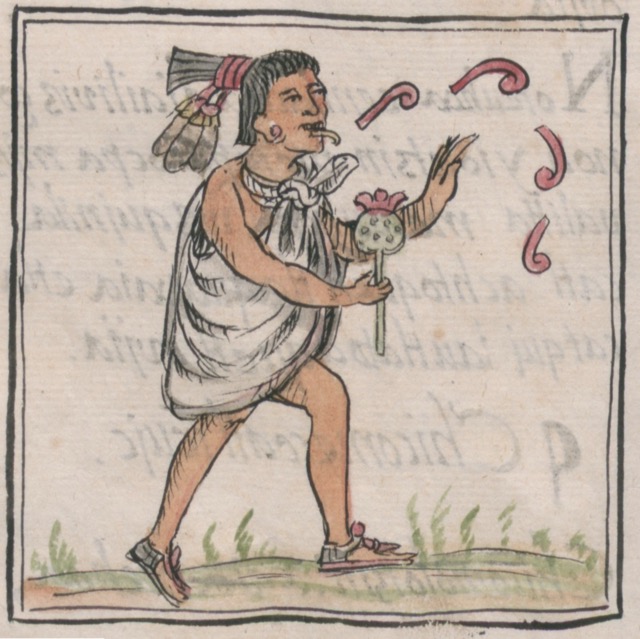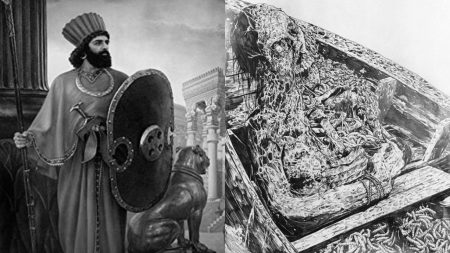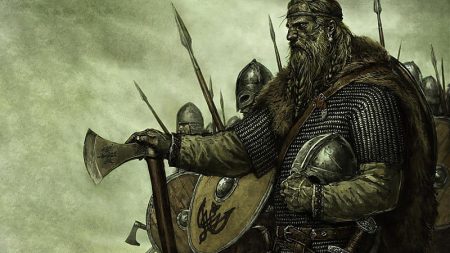Now, imagine a small creature, only about knee-high, with a playful twinkle in its eyes and an air of mischief. This, my friend, is a Chanekeh, Chaneque or Ohuican Chaneque (pronounced cha-neh-keh). They are one of the most intriguing characters in Mexican folklore.
The word “Chaneque” comes from the Nahuatl language, spoken by the Aztecs, and it means ‘inhabitants of dangerous places.’
Many people believe that they live in the forests, near rivers, or any place where nature is wild and untamed. Chaneques are not any mythical creatures. They hold a significant place in Mexican folklore. They embody the deep-rooted respect and reverence for nature found in Mexican culture.
People see them as the guardians of the natural world, as they protect the forests, animals, and even certain sacred places. Their origins can be traced back to the indigenous beliefs of the Aztecs and other native tribes, long before the arrival of the Spanish.
But, don’t let their small size and playful nature fool you. Chaneques are famous for their mischievous tricks, especially towards those who disrespect nature. They are also believed to have the power to shape-shift and become invisible. This makes them a fascinating subject of countless stories and legends.
So buckle up, as we dive deep into the world of Chaneques. We will explore their origins, characteristics, tales, and the vital role they play in the enchanting realm of Mexican folklore.
Table of Contents
- 1. Background of Chaneques
- 1.1 Etymology and Meaning of the Term Chaneque
- 1.2 Relation of Chaneque to the Indigenous Cultures, Primarily the Nahuatl (Aztec)
- 1.3 Cultural Importance and Representation of Chaneques
- 2. Physical Appearance and Characteristics of Chaneques
- 2.1 Detailed Description of Their Physical Appearance
- 2.2 Common Traits and Abilities Attributed to Chaneques
- 2.3 Variations in Descriptions Depending on Regions and Cultures
- 3. Behavior and Playful Nature of Chaneque
- 3.1 Mischievousness and Prankster-like Activities of Chaneque
- 3.2 Complex Relationship of Chaneque with Humans
- 3.3 Dual Nature as Protectors of Nature and Tricksters
- 4. Role of Chaneques in Mexican Folklore
- 4.1 Narratives and Myths Involving Chaneques
- 4.2 Their Role in the Ecosystem, as Protectors of Nature
- 4.3 Interaction with Other Creatures in the Mythology
- 5. Chaneques and the Spirit World
- 5.1 Connection of Chaneques with the Spirit World
- 5.2 Beliefs about Their Role in the Transition of Souls
- 5.3 Their Association with Certain Spiritual Practices and Rituals
- 6. Chaneques as Souls of Unbaptized Children in Catholic Beliefs
- 7. Comparison of Chaneques to Similar Creatures in Algonquian and Norse Folklore
- 8. Chaneques in Contemporary Culture
- 8.1 Depiction of Chaneque in Modern Literature, Film, and Other Media
- 8.2 Role of Chaneque in Current Mexican Folklore and Urban Legends
- 8.3 Influence on Popular Culture Outside of Mexico
- 9. Contemporary Legends and Testimonies Related to Chaneque
- 10. Impact of Chaneques on Mexican Society
- 10.1 Influence on Mexican Customs and Practices
- 10.2 Examples of Places or Events Where Chaneques Still Play a Significant Role
- 11. Final Thoughts on Chaneque
Background of Chaneques
Etymology and Meaning of the Term Chaneque
Have you ever wondered about the origin of the term “Chaneque”? The word, as strange as it sounds, is actually quite meaningful.
It is derived from the Nahuatl language, which was spoken by the Aztecs, an ancient civilization that thrived in the region now known as Mexico.
The term “Chaneque” translates to ‘inhabitants of dangerous places.’ It’s a fitting description, considering these creatures are believed to dwell in untamed parts of nature, such as deep forests, near rivers, or around rocky cliffs.
Relation of Chaneque to the Indigenous Cultures, Primarily the Nahuatl (Aztec)

The roots of the Chaneque legend are deeply intertwined with the indigenous cultures of Mexico, especially the Nahuatl-speaking Aztecs.
In the Aztec belief system, nature played a pivotal role, and it was embodied in various elements, including their mythology.
The Chaneques, as protectors of nature, symbolized the Aztecs’ respect and reverence for the natural world. These small but powerful beings were considered the guardians of animals, plants, and sacred places, ensuring the balance of the ecosystem.
The Aztecs, like other indigenous tribes, believed in the existence of a spirit world parallel to ours, and they regarded Chaneques as bridges between these two realms. These creatures were seen as playful yet potent spirits that could shape-shift, become invisible, and even control elements of nature.
Cultural Importance and Representation of Chaneques
Chaneques hold a special place in Mexican folklore. They represent more than just mischievous forest creatures.
They embody a powerful message about living in harmony with nature. Their stories remind us of the consequences of disrespecting the natural world. They teach us the importance of preserving and respecting nature.
Chaneques also represent the resilience of indigenous cultures. Despite centuries of change and outside influences, their legend endures.
They continue to be a significant part of Mexican folklore, inspiring stories, movies, and festivals. They symbolize the preservation of indigenous knowledge and traditions, maintaining Mexico’s cultural richness.
Physical Appearance and Characteristics of Chaneques
Detailed Description of Their Physical Appearance
- Chaneques are small creatures, standing at knee height, with a youthful and playful appearance.
- They have dark skin, resembling the earth tones of the forests they live in.
- Their eyes are bright and lively, radiating mischief and curiosity.
- Some Chaneques are depicted with pointy ears and sharp teeth, giving them an impish look.
- Despite their small size, they possess strength and agility, making them adept at moving between trees and disappearing into the underbrush.
Common Traits and Abilities Attributed to Chaneques
- Chaneques have magical abilities, with shape-shifting being one of their most intriguing powers.
- They can transform into animals or imitate human voices, often using these skills to play tricks on unsuspecting travelers.
- Chaneques also possess the ability to become invisible, allowing them to carry out their pranks and protect nature without being seen.
- While they are mischievous tricksters, they also have a dual nature, acting as protectors of nature and maintaining the balance of the ecosystem.
Variations in Descriptions Depending on Regions and Cultures
- Descriptions of Chaneques may vary slightly as you travel across different regions in Mexico.
- Some regions depict them as elf-like, while others portray them more like gnomes.
- These variations reflect the diverse cultural influences found throughout Mexico.
- Certain regions have specific names for Chaneques, such as Aluxes in the Yucatan Peninsula.
- Regardless of the regional differences, the core characteristics of Chaneques, as guardians of nature and symbols of Mexico’s indigenous heritage, remain consistent throughout the country.
Behavior and Playful Nature of Chaneque
Mischievousness and Prankster-like Activities of Chaneque
If you’ve ever heard the phrase “trouble comes in small packages,” it could very well be describing a Chaneque! Despite their small size, these creatures are known for their mischievousness.
Picture this: you’re walking through a forest, and suddenly, you can’t remember which path you took. Or perhaps, you put down your backpack for a moment, and when you turn around, it’s vanished!
These are the kinds of playful pranks that Chaneques are known for. They might lead you astray with mimicked voices or borrow your belongings without asking. But don’t worry, they usually return them after having their fun.
Complex Relationship of Chaneque with Humans
Chaneques have a rather complex relationship with humans. On the one hand, they’re known for their playful tricks, which can sometimes be a nuisance.
On the other hand, they are not inherently harmful and generally mean no serious harm. In fact, they are known to help lost travelers find their way back, especially those who show respect towards nature.
However, it’s also said that if a human disrespects nature, like harming animals or destroying plants, the Chaneques can get quite upset. They might play harsher pranks or even frighten the offender to teach them a lesson. So, the key to a good relationship with a Chaneque is simple: respect nature.
Dual Nature as Protectors of Nature and Tricksters
One of the most fascinating aspects of Chaneques is their dual nature. They are playful tricksters, always up for a good prank, but they’re also passionate protectors of nature.
They ensure the balance of the ecosystem and guard it from harm, whether it’s humans who disrespect nature or other potential threats.
In fact, their pranks often serve a purpose. By leading people astray or hiding their belongings, Chaneques remind humans to be mindful and respectful of the natural world.
They uphold the ancient belief that humans are just a small part of a vast ecosystem, and it’s our duty to protect and respect it.
So, while Chaneques might be small, they carry a big message about living harmoniously with nature. They are protectors and tricksters, an enchanting blend of mischief and wisdom, making them one of the most beloved characters in Mexican folklore.
Role of Chaneques in Mexican Folklore
Narratives and Myths Involving Chaneques
Chaneques play central roles in numerous narratives and myths throughout Mexican folklore. One popular tale tells of a lost traveler in the forest who hears a familiar voice calling his name, leading him even further astray.
Just when he starts to panic, he remembers the advice of a local elder to offer a gift to the Chaneques. He leaves a sweet fruit on the ground, apologizes for his intrusion, and soon finds his way back to the path. This story, like many others, illustrates the playful yet helpful nature of Chaneques.
Another myth tells of a lumberjack chopping down trees recklessly. His actions anger the local Chaneques, who frighten him with animal noises and illusions of dangerous creatures.
It’s only when the lumberjack promises to take only what he needs and replant more trees that the Chaneques leave him in peace. Such tales serve as lessons about respecting nature and its guardians.
Their Role in the Ecosystem, as Protectors of Nature
As mentioned earlier, Chaneques are seen as the protectors of nature. They maintain the balance of the ecosystem by ensuring that all plants, animals, and natural resources are respected and not exploited.
Their pranks and tricks, while amusing, often carry a deeper message about the importance of conservation and coexistence.
For instance, by leading a traveler off the path, they might be preventing them from disturbing a fragile habitat. Or by scaring a lumberjack, they might be preserving a centuries-old tree. These actions highlight their significant role as protectors of the natural world.
Interaction with Other Creatures in the Mythology
In the vast world of Mexican folklore, Chaneques don’t exist in isolation. They interact with various other mythical beings, each interaction weaving a more intricate tapestry of tales.
For example, they may work with the Tlaloques, the helpers of the rain god Tlaloc, to ensure enough rainfall for the forest. Or they might join forces with other nature spirits to protect a sacred site.
Their interactions with human characters are also of significance. These encounters often serve as moral lessons about respecting nature and its invisible caretakers. The fascinating interplay between Chaneques and other creatures, both mythical and human, truly enriches the captivating realm of Mexican folklore.
Chaneques and the Spirit World
Connection of Chaneques with the Spirit World
In the rich tapestry of Mexican folklore, Chaneques are not just inhabitants of the physical world but also have strong ties to the spirit world.
They are seen as a bridge between the two realms, embodying the indigenous belief in a world beyond what our eyes can see. Chaneques live in the natural world but can also interact with the spirit realm, giving them a unique role in the folklore.
They are believed to communicate with other spirits, deliver messages between the two worlds, and even guide the spirits of nature. In some narratives, Chaneques are depicted as helpers of the gods, assisting them in their duties related to nature and the spirit world.
Beliefs about Their Role in the Transition of Souls
Chaneques are also believed to have a role in the transition of souls, particularly those who pass away at a young age. Some stories suggest that Chaneques help guide these young souls to the afterlife, ensuring they don’t get lost between the two worlds.
This belief reflects the indigenous view of death as a continuation of life in a different realm, with Chaneques acting as guides in this journey.
Their Association with Certain Spiritual Practices and Rituals
Due to their connection with the spirit world, Chaneques are often associated with certain spiritual practices and rituals.
For instance, before embarking on a journey through the forest, a traveler might leave an offering for the Chaneques, asking for their protection and guidance. This could be a piece of fruit, a small handmade trinket, or even a respectful message.
During certain festivals, especially those related to nature, stories about Chaneques are shared, and rituals are performed in their honor.
These practices serve to acknowledge the presence of Chaneques and their important role in maintaining the balance between the physical world and the spirit realm.
Chaneques as Souls of Unbaptized Children in Catholic Beliefs
In Catholic beliefs, chaneques have been regarded as the souls of children who died without receiving the Christian sacrament of baptism.
These children, according to ancient Mexican folklore, transform into these mischievous, magical beings that inhabit various hidden and dangerous places in nature.
As souls that did not undergo the purification ritual of baptism, chaneques are often depicted as demonic and malevolent creatures that prey on people, especially those who wander alone in the forests or dense jungles of Mexico.
These magical beings intentionally attract people, often confusing and disorienting them, causing them to get lost and be vulnerable to the chaneques’ pranks and malevolence.
In certain extreme cases, chaneques are even believed to scare people to death, causing their soul to leave their body and then be captured by the chaneques who imprison it underground.
In order to reclaim their soul and avoid falling ill or dying, it is said that victims must perform a specific ritual. Failure to do so will have dire consequences, as a person’s soul would remain in the clutches of the malicious chaneques.
The notion of chaneques as unbaptized children’s souls is likely rooted in pre-colonial times and was integrated into popular Catholic beliefs as Christianity spread through Mexico.
Although these ancient legends persist and are deeply woven into Mexican folklore, it is important to remember that they are a product of centuries-old beliefs that evolved over time, reflecting the cultural and religious influences of the regions where they originated.
Today, chaneques may be depicted in various ways, but their connection to the souls of unbaptized children remains an intriguing aspect of their lore
Comparison of Chaneques to Similar Creatures in Algonquian and Norse Folklore
When exploring the realm of mythical creatures, it’s fascinating to discover similarities between the legends of different cultures.
Chaneques, for instance, share some common characteristics with creatures found in both Algonquian and Norse folklore.
In Algonquian mythology, we find the Pukwudgies, small woodland beings known for their trickster-like behavior.
Much like Chaneques, Pukwudgies can be helpful or mischievous, depending on how they are treated. They also have a strong connection with nature and are known to shape-shift into various forms.
Similarly, in Norse mythology, we find creatures like the Huldra, who are forest-dwelling spirits with a penchant for mischief.
They are known to lead travelers astray and play tricks on them, much like Chaneques. Additionally, they are protectors of nature, ensuring harmony within the ecosystem.
Despite these similarities, there are also some key differences between Chaneques and the creatures found in Algonquian and Norse folklore.
For instance, Pukwudgies are sometimes depicted as malevolent beings, while Chaneques are generally seen as playful and harmless.
Huldras, on the other hand, are usually portrayed as beautiful women with cow or fox tails, which is quite different from the more child-like appearance of Chaneques.
One of the main common themes among these creatures is their connection to nature and their role as protectors of the environment.
They embody the idea that humans must coexist peacefully with the natural world, respecting its delicate balance.
Another shared theme is their trickster-like behavior, which serves to remind humans of their place in the world and the importance of humility.
In conclusion, while Chaneques are unique to Mexican folklore, they share some common themes and characteristics with creatures from other cultures. This highlights the universality of certain ideas and beliefs, showing that despite our differences, we all share a deep connection with the natural world and the stories we create to understand it.
Chaneques in Contemporary Culture
Depiction of Chaneque in Modern Literature, Film, and Other Media
Chaneques continue to be a source of fascination in modern culture, and their stories have found their way into various forms of media.
In literature, they often appear as intriguing characters in novels and short stories, adding a touch of mystery and cultural richness to the narrative.
In film and television, Chaneques have been portrayed in a variety of ways, from mischievous forest spirits to adorable animated characters.
They’re featured in Mexican films and TV shows, as well as in international productions, where their playful nature and unique characteristics add depth to the storylines.
Children’s books and animated shows often use Chaneques to teach important lessons about respect for nature, empathy, and the importance of understanding different cultures. Their stories are a great way to introduce young audiences to these timeless values.
Role of Chaneque in Current Mexican Folklore and Urban Legends
In current Mexican folklore, the lore of the Chaneques is very much alive. They continue to be central figures in many tales and urban legends, especially in rural communities where the connection to nature and the old ways remain strong.
For instance, there are tales of Chaneques appearing to lost travelers, or stories of them playing tricks on people who disrespect nature. These contemporary legends serve as a reminder of the cultural importance of Chaneques and the enduring relevance of their stories.
Influence on Popular Culture Outside of Mexico
The charm of the Chaneques has also crossed borders, influencing popular culture outside of Mexico. Elements of their mythology have been incorporated into international literature and media, contributing to the global tapestry of mythical creatures.
In video games, for instance, characters inspired by Chaneques can be found, often depicted as forest spirits or nature guardians.
Similarly, in fantasy literature and film, the idea of a playful, mischievous creature that protects nature is a recurring theme, reflecting the universal appeal of the Chaneque mythology.
Contemporary Legends and Testimonies Related to Chaneque
Recent Testimonies and Stories About Chaneque
While Chaneques are part of ancient Mexican folklore, stories and testimonies about these little creatures continue to circulate in modern times. Some people, particularly in rural areas, claim to have seen or interacted with Chaneques, their experiences giving rise to new legends and anecdotes.
One recent story tells of a farmer who found his tools missing or misplaced every morning. After a few days, he decided to stay awake at night to see what was happening.
To his surprise, he saw little beings playing with his tools, laughing and scampering around. He remembered the old tales about Chaneques and decided to leave out some sweet bread as an offering. From that day on, his tools were no longer disturbed.
Another testimony comes from a group of hikers who claimed to have gotten lost in a forest, even though they had a map and were following a marked trail.
They felt as if they were walking in circles. Remembering the stories of Chaneques leading people astray, they decided to ask for the Chaneques’ help and immediately found their way back to the trail.
Relevance of These Legends in Modern Society
These contemporary legends and testimonies highlight the enduring relevance of Chaneques in Mexican culture.
They serve as reminders of the rich folklore and the deep respect for nature embedded in the society. Even in our technologically advanced era, these stories continue to captivate people, demonstrating the timeless appeal of folklore.
Moreover, these tales and encounters with Chaneques often convey important messages about respect for the environment and the need for harmony with nature.
They remind us of the ancient wisdom that sees the natural world as a living entity, filled with spirits and beings that deserve our respect.
In a world grappling with environmental issues, these tales about Chaneques and their role as protectors of nature acquire a new relevance. They reinforce the importance of environmental stewardship, respect for biodiversity, and the need for sustainable practices.
Impact of Chaneques on Mexican Society
Influence on Mexican Customs and Practices
The presence of Chaneques in Mexican folklore has left a significant imprint on Mexican customs and practices.
For instance, in some rural communities, it’s customary to leave offerings of food or small trinkets for the Chaneques, especially when embarking on a journey through the woods or when building a new home.
These customs reflect the belief in the Chaneques as protectors of nature, as well as their capacity for mischief if not respected. These practices are not merely about superstition; they signify a deep reverence for nature and the belief in coexisting peacefully with all elements of the environment.
Examples of Places or Events Where Chaneques Still Play a Significant Role
Chaneques continue to play a significant role in certain places and events in Mexico. In regions rich with forests and natural beauty, such as Veracruz and Oaxaca, tales of Chaneques are especially prevalent. Many locals still believe in their presence and influence.
During certain festivals and events, the Chaneques are often invoked and celebrated. For example, during the Day of the Dead celebrations, some families leave offerings for the Chaneques along with those for their departed loved ones.
This practice highlights the continued relevance of Chaneques in Mexican society and their enduring influence on its customs, perceptions, and traditions.
Final Thoughts on Chaneque
To sum up, the cultural significance of Chaneque in Mexican folklore cannot be overstated. These creatures, believed to dwell in the natural world, have been a part of the country’s rich tapestry of legends and myths for centuries.
They serve as symbols of the deep respect for nature that is embedded in Mexican culture and tradition. The tales of their pranks, their assistance to lost travelers, and their role as protectors of the environment reflect important values like respect, balance, and harmony with nature.
As we navigate the challenges of the modern world, these lessons from the Chaneques of Mexican folklore are more relevant than ever.
Sources:
Read More Interesting Stories:
- Who Defeated The Vikings: Factors Leading to Decline of Vikings
- Fascinating Story of Captain Jack Bonavita: The One-Armed Lion Tamer
- Strange case of Vasu Bhanot – Parallel Universe in Nainital, India
- Meet Shakuntala Devi: The Human Computer of the World
- 3 Reasons Why School Buses Are Yellow In Color





